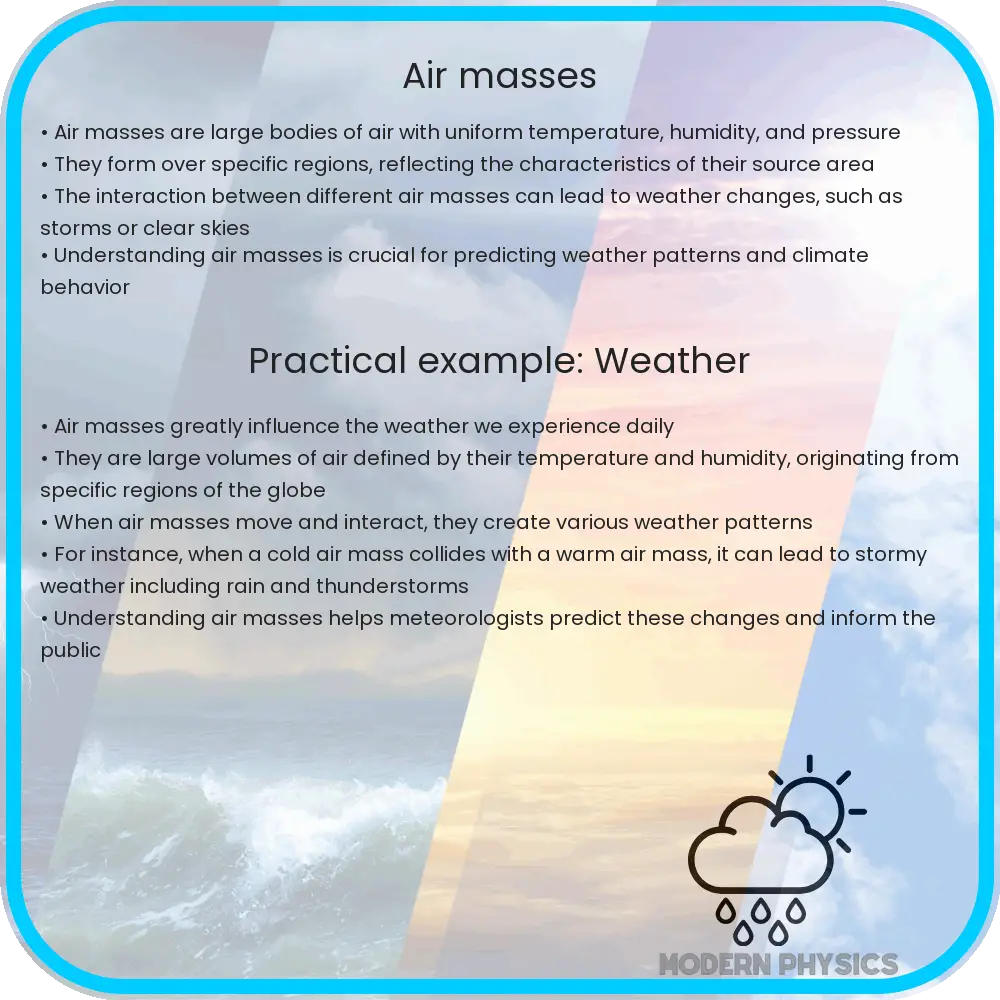Explore the formation, movement, and weather effects of air masses, essential components in meteorological forecasting.

Understanding Air Masses: Origins, Movement, and Impact on Weather
Air masses are large volumes of air that cover hundreds or thousands of square kilometers and possess a uniform temperature and humidity throughout. These vast bodies of air play crucial roles in dictating weather patterns and are essential for meteorologists in forecasting weather. By understanding where air masses come from, how they move, and their effects on weather, we can gain deeper insight into meteorological phenomena.
Origin of Air Masses
Air masses are primarily formed over large and relatively uniform geographic regions known as source regions. These regions can be vast expanses of ocean, large tracts of flat land, or expansive ice fields. The key characteristics of an air mass – temperature and humidity – are influenced by the type of surface over which the air mass forms. For example, air masses that develop over northern Canada in winter are cold and dry, whereas those forming over the Gulf of Mexico will be warm and moist.
The classification of air masses is based on latitude and the nature of the surface in the source region. For instance:
- Arctic (A) or Antarctic (A)A: Extremely cold and dry
- Polar (P): Cold and relatively dry
- Tropical (T): Warm and moist
- Continental (c): Formed over land, likely to be dry
- Maritime (m): Formed over oceans, likely to be moist
Movement of Air Masses
The movement of air masses is primarily driven by the general circulation of the atmosphere, which in turn is influenced by the Earth’s rotation and the differential heating of its surface. High-altitude winds, especially jet streams, play a significant role in directing the movement of air masses across continents and oceans.
When air masses move away from their source regions, they carry their distinct temperature and humidity characteristics with them. As they traverse different geographical landscapes and encounter other air masses, their initial properties begin to change.
Impact on Weather
As air masses collide with others having different temperature and humidity characteristics, they create weather fronts. A front represents a boundary zone between two different air masses. The nature of the weather at a front depends on the types of air masses involved:
- Cold Fronts: Occur when a colder air mass displaces a warmer one, leading to sudden temperature drops and typically producing short periods of intense precipitation and storms.
- Warm Fronts: Form when a warm air mass overtakes a cold air mass, resulting in gradual temperature increases and prolonged periods of precipitation.
The interaction between different air masses can lead to various weather phenomena, including thunderstorms, cyclones, and snowfall, depending on the characteristics of the interacting air masses and the underlying geography.
Forecasting Techniques and Predictive Challenges
The prediction of weather involves analyzing the movement and interaction of air masses. Meteorologists employ various tools such as satellite imagery, radar data, and weather balloons to track these massive bodies of air. Computer models play a crucial role in simulating the possible paths air masses might take and predicting how they will affect the weather in different regions.
Despite advances in technology, forecasting weather can still be highly challenging. The dynamic nature of air masses and their interactions with the Earth’s varied topography and water bodies can lead to unexpected weather events. This unpredictability makes accurate weather prediction one of the most complex tasks in meteorology.
The Global Impact of Air Masses
Air masses do not only affect local weather; they play a significant role in global climate patterns. For instance, the displacement of polar air masses toward the equator can lead to severe winters in temperate zones, while tropical air masses moving poleward may cause heatwaves in higher latitudes. Understanding these patterns helps scientists predict seasonal weather phenomena like El Niño and the monsoon rains, crucial for agriculture, water management, and disaster preparedness across the globe.
Furthermore, the study of air masses and their trajectories supports efforts in climate change research. As global temperatures rise, changes in air mass characteristics and paths may indicate broader shifts in climate dynamics, providing valuable data for climate models and sustainability strategies.
Conclusion
Air masses are more than just large bodies of air; they are the driving force behind much of our weather and climate. From shaping daily weather conditions across the globe to influencing long-term climate trends, these impressive atmospheric phenomena play an integral role in our understanding of the Earth’s atmosphere. By studying their origins, movements, and impacts, meteorologists can better predict weather patterns, providing crucial information for planning and preparedness in various sectors. Their dynamics offer a fascinating glimpse into the complexities of our planet’s environment, emphasizing the intricate connections between the atmosphere, oceans, and land surfaces. Understanding air masses is not only essential for weather prediction but also for grasping the broader aspects of Earth’s climate system.
